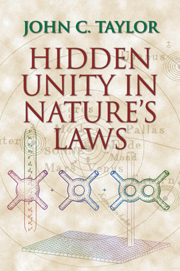Book contents
- Frontmatter
- Contents
- Preface
- 1 Motion on Earth and in the Heavens
- 2 Energy, Heat and Chance
- 3 Electricity and Magnetism
- 4 Light
- 5 Space and Time
- 6 Least Action
- 7 Gravitation and Curved Spacetime
- 8 The Quantum Revolution
- 9 Quantum Theory with Special Relativity
- 10 Order Breaks Symmetry
- 11 Quarks and What Holds Them Together
- 12 Unifying Weak Forces with QED
- 13 Gravitation Plus Quantum Theory – Stars and Black Holes
- 14 Particles, Symmetries and the Universe
- 15 Queries
- APPENDIX A The Inverse-Square Law
- APPENDIX B Vectors and Complex Numbers
- APPENDIX C Brownian Motion
- APPENDIX D Units
- Glossary
- Bibliography
- Index
12 - Unifying Weak Forces with QED
Published online by Cambridge University Press: 20 January 2010
- Frontmatter
- Contents
- Preface
- 1 Motion on Earth and in the Heavens
- 2 Energy, Heat and Chance
- 3 Electricity and Magnetism
- 4 Light
- 5 Space and Time
- 6 Least Action
- 7 Gravitation and Curved Spacetime
- 8 The Quantum Revolution
- 9 Quantum Theory with Special Relativity
- 10 Order Breaks Symmetry
- 11 Quarks and What Holds Them Together
- 12 Unifying Weak Forces with QED
- 13 Gravitation Plus Quantum Theory – Stars and Black Holes
- 14 Particles, Symmetries and the Universe
- 15 Queries
- APPENDIX A The Inverse-Square Law
- APPENDIX B Vectors and Complex Numbers
- APPENDIX C Brownian Motion
- APPENDIX D Units
- Glossary
- Bibliography
- Index
Summary
How weak forces, responsible for beta decay, and so on, and electromagnetism have a heavily disguised unity.
What Are Weak Forces?
Newton, Faraday and Einstein each believed that there must be some sort of unity in the forces of nature. Faraday, having unified electricity and magnetism, conducted experiments to try to find a connection between these forces and gravity. From 1922 until his death in 1955, Einstein was trying mathematically to unify gravity with electromagnetism. In the event, the force that was eventually unified with electromagnetism is one that was unknown to Newton and Faraday, and perhaps not considered very important by Einstein. This is the so-called weak force. In previous chapters I have ignored the weak force, but now I must explain what it is.
In 1896 (a few months after the discovery of X-rays) Henri Becquerel in Paris discovered the radioactivity of uranium. Studied further by Marie and Pierre Curie, the nature of radioactivity was finally elucidated by Rutherford and Soddy in Montreal during the early 1900s.
In radioactivity, an atomic nucleus emits “rays”, unpredictably but with a definite probability per unit time, often changing into a different nucleus in the process. By a historical accident, three totally different processes are lumped under the heading “radioactivity”. One is the emission of alpha-particles, the nuclei of helium atoms, each made up of two protons and two neutrons. This happens as a result of the strong, nuclear forces. The only reason that it happens slowly (slowly compared to the time for an alpha particle to traverse the nucleus) is that the alpha particle's wave function has only a very small “tail” outside the nucleus.
Information
- Type
- Chapter
- Information
- Hidden Unity in Nature's Laws , pp. 324 - 351Publisher: Cambridge University PressPrint publication year: 2001
